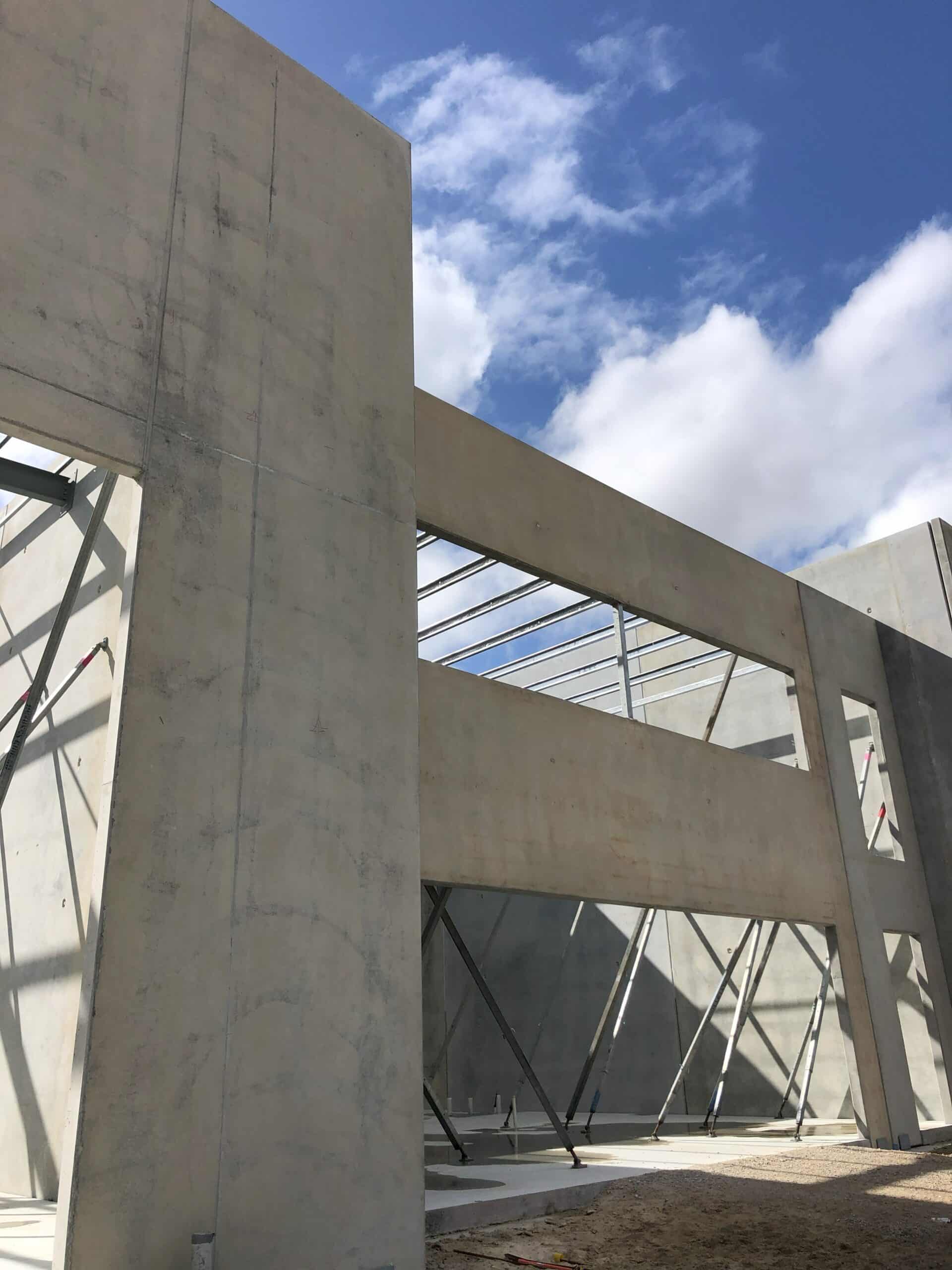Are you considering your construction options for a commercial build in Perth? Tilt-up panel construction might be the perfect solution. Offering speed, strength and cost-efficiency, this method has become increasingly popular. However, like any building method, you should weigh its pros and cons. Aligning your planning with the specific requirements of your project is key to success.
We’ll help you determine if tilt-up panel construction is the right fit for your commercial venture.
What is Tilt-up Panel Construction?
Tilt-up Panel construction is a building method where large concrete wall panels are cast horizontally on-site. Once cured, these panels are lifted into place, forming the building’s walls. This process starts with site preparation, creating a suitable base for casting the concrete panels. Concrete is then poured into forms to create the wall panels. After curing, specialised equipment tilts the panels into their upright position. Finally, the panels are secured to the building’s foundation and roof structure.
One of the main advantages of tilt-up panel construction is its speed. As panels are cast and cured on-site, the need for transportation is removed. This helps to reduce delays and costs associated with moving large prefab structures. This method also allows for greater flexibility in design, as panels can be customised to meet specific project requirements.
Legal and Safety Guidelines
Tilt-up panel construction demands a safe execution. Following safety regulations and industry standards helps avoid negative consequences. These include injuries, property damage and legal issues.
CPCCCM1016A: Safety Requirements
This unit outlines safety requirements for constructing and erecting concrete tilt-up panels. Key areas include:
Risk Assessment and Control
Identify potential hazards during the tilt-up process, including casting, curing, lifting and erection.
Safe Work Practices
Outline clear procedures for each stage of construction. Prioritise worker safety and minimise risks.
Personal Protective Equipment (PPE)
Ensuring workers have and wear appropriate PPE.
Crane and Lifting Operations
Implementing safe crane operation procedures.
Emergency Procedures
Consider developing and practising response plans outlining actions required in case of emergency.
By following these guidelines, builders can create a safer working environment and avoid accidents. Adherence to these standards protects workers and ensures the long-term structural integrity of constructed buildings.
Common Applications of Tilt-up Panel Construction
Tilt-up panel construction is a versatile and efficient solution for a range of projects. Its speed and low cost make it a popular choice for commercial and residential developments.
Tilt-up panels are well-suited for large-scale commercial projects such as warehouses, distribution centres and industrial buildings. This method’s ability to create vast, open interior spaces, combined with its speed of construction, makes it an ideal choice. Additionally, its durability and resistance to fire, pests and weather make it a reliable option for industrial applications.
Tilt-up panel construction is also gaining traction in the residential sector. Townhouses and apartments can benefit from tilt-up’s cost-effectiveness and structural integrity. For those seeking a custom home, tilt-up panel construction is durable and offers design flexibility and customisation. Tilt-up garages and workshops are also becoming popular home additions.
Construction using panels is not limited to new builds, it can also be used for additions and renovations. Existing structures can be expanded to create additional space without compromising appearance or functionality. This adaptability makes tilt-up construction an attractive choice.
Explore what tilt-up construction can do for your build.
Why Tilt-Up Panel Construction is Ideal for Australian Conditions
Australia’s diverse climate and geographical conditions present unique construction challenges. Tilt-up panel construction offers several advantages that make it well-suited to the Australian environment:
Geographical Benefits
Australia’s vast landscape can pose challenges to traditional construction methods. Tilt-up panel construction overcomes many of these obstacles by casting concrete panels on-site. Doing so reduces transport costs and environmental impact. This on-site casting also allows for better quality control as well. Panels can be inspected and adjusted immediately if required.
Weather Resistance
Australia experiences a wide range of weather conditions, including extreme heat, bushfires and cyclones. Tilt-up concrete construction offers exceptional durability and resistance to these elements. Concrete panels are designed to withstand harsh weather conditions long-term. This durability benefits regions prone to severe weather events, keeping buildings safe and functional over time.
Earthquake and Cyclone Resistance
Tilt-up panel construction’s inherent strength and rigidity make it well-suited to areas prone to earthquakes. The monolithic concrete structure can effectively resist lateral forces, reducing the risk of structural damage. In cyclone-prone areas, tilt-up buildings are designed to meet stringent wind load requirements, offering increased safety and resilience.
Benefits of Tilt-Up Panel Construction
Tilt-up panel construction offers numerous advantages for both builders and building owners:
Cost Advantages
Fewer materials and less labour compared to traditional methods can lower costs significantly. The on-site construction of panels reduces transport costs and waste.
Quick Builds
The efficient process of casting, curing and erecting panels can shorten construction timelines. Projects can be completed faster than with conventional methods.
Aesthetic Flexibility
Modern techniques allow for diverse finishes, textures and colours, offering design versatility. This flexibility enables customisation to meet aesthetic and functional requirements. This ensures the final product is both attractive and suited to its purpose.
Reduced Maintenance
As mentioned before, tilt-up panels offer excellent durability and resistance to weather, pests and fire. This results in lower maintenance costs over the building’s existence, providing long-term value to building owners.
Energy Efficiency
Tilt-up buildings can be designed with energy efficiency in mind. The thermal mass properties of concrete help regulate indoor temperatures, reducing heating and cooling costs and improving overall energy performance.
Group One Construction: A Builder You Can Depend On For Your Tilt-up Panel Construction
Tilt-up panel construction offers numerous benefits for Australian projects. It’s efficient, with panels being built on-site, saving time and costs. The strong concrete structure withstands our climate and potential natural disasters.
Interested in tilt-up panels? Contact Group One Construction for expert advice and a quote. We’re committed to delivering quality and reliability for your commercial build.



